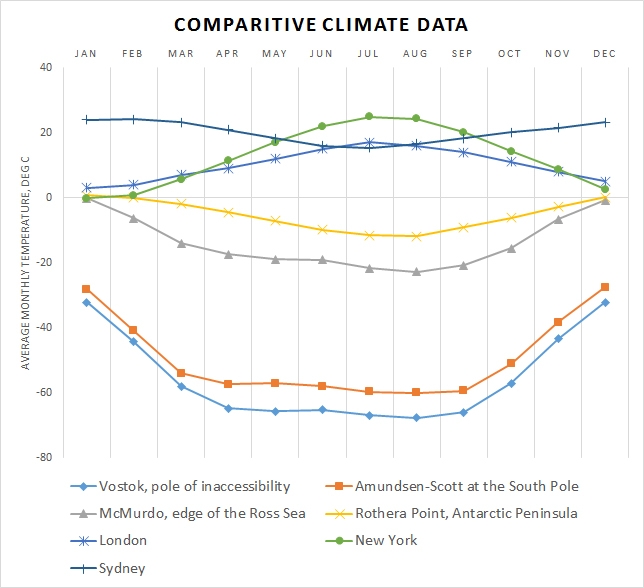Antarctica Lesson Plan Suggestions
Suggestions and ideas of how to use some of the pages on this site to deliver different subjects with an Antarctic theme.
1/ Climate graphs and Data
Subjects - Mathematics, Geography, IT
- Using the climate data on one or more of these
pages:
Antarctica climate graph comparative | Australian stations | Extreme south
Use the data from one or more tables to produce graph/s from those given.
This can be done in Excel, or the table/s can be printed out to be used in part or in full to produce graphs using pencil and graph paper.
Whenever I get students to plot graphs in Excel, they manage a graph of the right shape ok, but the first attempt often gives labels and axes that can be meaningless or difficult to understand. Plotting a graph by following the Excel wizard is easy. Getting a meaningful result that can be presented understandably to others is much more difficult, so I suggest focusing on this aspect of it too. If you don't, then your students will have a lot of quickly produced poor graphs.
If this is too difficult for your students, they could make a graph without labels (highlight and delete those generated automatically), print out what they have, then cut out the physical copy to be pasted into their book and labeled manually.
For younger or less able students, you could print out blank graphs yourself and ask them to label them appropriately.

2/ Animal life and cold adaptations - humans in the cold
Subjects - Science, Geography
- Variety of animals in Antarctica
Using the links from this page - Antarctic animals - write a summary or construct a Power Point or similar presentation about Antarctic Penguins, Seals, Whales or other birds.
Penguins in particular can be found here - Antarctic penguins
Relate to this list of Endangered Antarctic Animals. - Adaptation to a cold environment
The links below can be used as a basis for projects either individual, group or whole class.
Cold adaptations follow pretty much the same principles for all animals, so it isn't so important which animal a student studies. A class wall display could be produced covering all the animals including humans or not. Just remember that warm and cold blooded animals do things differently.
Warm blooded - Large size retains heat. Insulation from fur or feathers trapping air and/or from blubber (fat) under the skin. Extremities such as feet and flippers have poor blood flow and little tissue to lose heat, they are controlled by deeper muscles. Behavioural means such as head away from the cold in winter, huddle in groups and lay down fat in the good times.
Cold blooded - A more difficult concept, better avoided other than for more able and probably post-16 age students. Stop-start lifestyles when it gets warmer. Anti-freeze in body fluids and/or able to withstand desiccation. Long slow lives.
Animal adaptations in Antarctica
Examples
of the ways that some Antarctic animals are adapted to the cold
can be found here -
Antarctic
animal adaptations.
Adaptation to cold by all kinds of
animals is covered here -
Cold adaptations
Adaptation to cold by penguins in particular
is covered here -
Penguins adaptations to cold
- Humans and cold
Human adaptations to the cold is covered here -
How human survive cold conditions
When humans fail to
cope with the cold -
Humans and hypothermia
Making yourself more cold tolerant
-
Cold acclimation and acclimatization
Staying well in
cold temperatures and weather -
Human health and the cold
Staying fit and active in cold
weather -
Sport in cold temperatures
3/ What is Antarctica for? Conservation and Politics
Subjects - Science, Geography, Citizenship
- Antarctica doesn't belong to any one nation, it is set aside outside of the usual way that the world is organised. It is an excellent example of a different way of doing things and can be used to raise questions about how we should deal with our world outside of any national interests.
The Antarctic Treaty is central to any discussion
about what happens in Antarctica
Summary of the Antarctic Treaty |
Treaty in full
An overview of past and present
threats to Antarctica can be found here -
Human impacts on Antarctica
...and current solutions
here -
Conservation in Antarctica
Pages on particular
threats -
Fishing |
Mining and oil exploration |
Pollution |
Whaling and Sealing |
Tourism
- For a project on Antarctica focusing on governance,
regulations and how to preserve Antarctica while also utilizing
it, there is an
introductory Presentation here.
This is aimed at the 14-16 age group and could be adapted readily to projects with a variety of emphases.
4/ Explorers and History
Subjects - History, English
- Choose one of the explorers from this
pre-amble page
Antarctic explorers, follow the links through to the
details pages and research-write a diary entry for a single
day that might have happened during the expedition.
- Presentation of Ernest Shackleton and
his 1914-1917 Imperial Trans-Antarctic Expedition.
Fully illustrated by Frank Hurley's pictures with a concise
accompanying narrative.
For the Shackleton expedition using this time line and map page convert the events to coincide with the students own life with the end as of today. i.e. work backwards to establish how long ago the expedition would have set off in the students life (March when I was in year 6 - for instance) and then fit in with other events. This gives a good idea of how long these expeditions took, putting it into perspective. Time line of Ernest Shackleton's life
- Poetry / Creative writing - Using these pictures for inspiration, describe what it might be like to be there.
